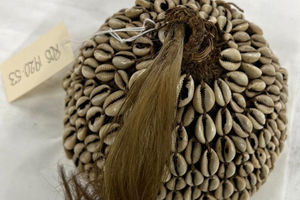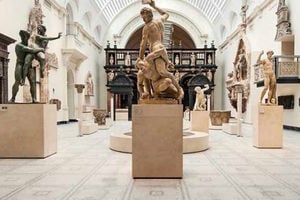
This drum is said to have been used in the 1880s by the first Catholic converts in Buganda who were under Father Lourdel's and Brother Amans' instructions. PHOTOS | MICHAEL KAKUMIRIZI
The relics of the Uganda Martyrs including chains that bound them; crosses made from the trees where Noa Mawaggali, Mathias Kalemba Mulumba, and Charles Lwanga were tied; the jawbone of Mulumba; and the bone of Kalori Lwanga are on display at an exhibition showing for the first time ever in Uganda.
The exhibition entitled “God and Caesar: The Holy Uganda Martyrs@60”, organised by Uganda Martyrs University (UMU), the government of Uganda, and the Catholic Church, was officially launched on September 14, 2024, at UMU’s Rubaga campus in Kampala. It closes this Thursday, October 31.
The Uganda Martyrs became the first Black Saints canonised by the Catholic Church in modern times after Pope Paul VI presided over a ceremony at the Vatican on October 18, 1964. The six-week exhibition is showcasing rarely seen archival documents, photographs, and films from the canonisation ceremony that this year marks a 60th anniversary.
Islam was the first foreign religion to arrive in Buganda Kingdom in 1844, and it quickly gained converts within the Kabaka’s royal court. The first Europeans arrived in Buganda in 1862. In 1877, the first Protestant missionaries arrived in Buganda, at the behest of Kabaka (King) Mutesa I via Henry Morton Stanley. Catholic missionaries from France arrived in 1879.
Competition for political influence began swiftly, and soon the foreign religious teachings and values clashed with the beliefs and values of the traditional absolute monarchy.
Twenty-three Anglican Martyrs together with the 22 Catholics were killed on the watch of Kakaka Mwanga of Buganda for disobedience beginning in 1885. Most of the 22 Martyrs were pages in the king’s palace. Thirteen of these were burnt to death at Namugongo and nine killed in other different places, according to the Uganda Martyrs Catholic Shrine in Namugongo.
The first Catholic saint to be martyred on November 15, 1885 was the King’s major domo and Christian leader, Joseph Mukasa Balikuddembe. He was killed because he had pleaded with the king not to kill Bishop James Hannington, an Anglican Missionary, who had made an attempt to enter Buganda from the east, then considered to be the backdoor of the kingdom. Balikuddembe was beheaded and burnt at Nakivubo swamp, at the Kampala City centre.Gory executions
In May 1886, Kabaka Mwanga—angered at converts’ disobedience—ordered the execution of those who professed Christianity. The main persecution that led to the Namugongo Holocaust broke out on May 15, 1886 at Munyonyo, then a royal enclosure near Lake Victoria. Kabaka Mwanga condemned Christians to death with the spearing and condemning to death of Denis Ssebuggwawo and Andrew Kaggwa.
Born in Busoga, Mulumba was enslaved in his youth. By the early 1880s he had risen to become the head assistant to the county chief of Ssingo in Buganda. He was baptised into the Catholic Church on Pentecost Sunday in 1882.
Mulumba was martyred in May 1886 in Old Kampala. His executioners cut off his arms and legs, and then roasted his skin on a fire before his eyes. Traditional herbs were applied to the wounds to stop him from over bleeding. He is said to have died unprotesting three days later from thirst, with the name of God on his lips.
There is a cross made of muvule wood, hewn from the tree to which Mulumba was affixed as he was dismembered, dying in utter agony. There are the chains that bound Balikuddembe as he was led to his death. There is a crucifix that had once belonged to Charles Lwanga, the leader of the pages at Mwanga’s court, who was among the martyrs at Namugongo.
On display is the crucifix given to St Kizito by St Lwanga. Kizito Omuto was the youngest person slain during the time of persecution. He was baptised in May 1886 by Charles Lwanga, the leader of the Christian community in Kabaka Mwanga’s court, and burned alive on June 3, 1886 in Namugongo. He is the patron saint of children.

The cross of St Mathias Kalemba Mulumba, one of the Ugandan martyrs
Priceless relics
The relics testify to the martyrs’ agony and the heroism. There is the Small Catechism in Luganda and French written in 1881. This catechism was used by pioneer missionaries to teach the first converts, among whom were the future martyrs. It included an alphabet, the creed, and the Hail Mary.
On display is Father Simeon Lourdel’s report to the Superior General in Algiers about the deaths of the martyrs at Namugongo dated June 25, 1886. There is the banner that was displayed at St Peter’s Basilica on October 18, 1964 as well as an 18-minute film from the mass.
On show is a rosary and pen of Bishop Léon Livinhac, who was Vicar Apostolic of Victoria Nyanza. He was in Mengo in May 1886, at the time the Uganda Martyrs were immolated. In 1890, he was made Superior General of the Missionaries of Africa.
The exhibition is curated by Dr David Ngendo Tshimba of the Centre of African Studies at Uganda Martyrs University, with assistance of the planning committee co-curators, who included Fr Richard Nnyombi of the Missionaries of Africa, Frs Anthony Musuubire and John Vianney Kitoolo of the Archdiocese of Kampala, John Baptist Ssemitego from UMU’s Guild and Prof Derek R. Peterson of the University of Michigan, USA. His Grace Paul Ssemogerere, the Archbishop of Kampala, oversaw the return of the Uganda Martyrs’ relics from Rome on September 9, 2024. The relics were delivered in Kampala by Fr Nyombi.
“The show contains four pieces of memorabilia, 25 rarely seen photographs/artistic impressions and 7 first-class relics,” Ngendo-Tshimba told Sunday Monitor.
Making of the Martyrs
According to the curators, shortly after the fires at Namugongo had died down, Catholic missionaries went through the ashes and gathered up the bodily remains of Charles Lwanga and Mattias Mulumba who were separately executed. Other non-bodily remains of the incinerated martyrs were later gathered up. They were convinced that the young men who had died there were martyrs in the faith. In 1912 the Vatican approved the veneration of the martyrs; and on June 6, 1920 they were beatified. But it was Ugandan Christians—not the Vatican—who made the martyrs into Africa’s first modern saints.
There is Archbishop Charles Lavigerie’s letter to Msgr Leon Livinhac dated March 22, 1887. Here Lavigerie responds to the news of the martyrdom, saying that the Pope had instructed Livinhac to “begin immediately the first preparatory information for the beatification and canonisation of these generous Christians.”
On display is the “Decree for the Beatification of the Uganda Martyrs” issued by Pope Benedict XV dated June 6, 1920. There is the “Decree of the Canonisation of the Uganda Martyrs” issued by Pope Paul VI in October 1964.
“In the space of a short time they have given so many examples of virtue, and they have shown such greatness of spirit that the praises of those holy men are rightly said to be equal to those whose blood the beginnings of Christian society were decorated,” it reads in part.
On October 18, 1964, at a service in St Peter’s Basilica in Rome, Pope Paul VI canonised 22 Catholic martyrs. At the service that day a choir of Ugandan students sang several hymns to the martyrs composed by the great musician Joseph Kyamgambidwa. It was the first time that music had been performed in St Peter’s in a language other than Latin.
Kyangambidwa’s “Uganda Martyrs Oratorio” was performed by a choir of around 100 singers, many of them Ugandan students studying in Europe. The oratorio consists of 22 hymns. At the canonisation service the choir sang ‘Karoli Lwanga wuuyo omulwanyi owamaanyi’ (Lwanga the invincible religious warrior), ‘Kizito Omuto ye wange,’ (Kizito my younger brother) and others. It was the first time that a choir had sung in a language other than Latin during a mass at St Peter’s Basilica, and the first time that African drums had resounded in the holy precincts.
Kodak moments
There is a picture of Kyangambidwa with the choir singing his “Uganda Martyrs Oratori” during a rehearsal in October 1964. He was also captured playing the amadinda. There are drummers and choristers preparing to sing Kyamgambidwa’s Oratorio.
There is a photo of Pope Paul with the Ugandan delegation, including Archbishop Dr Leslie Brown, Archbishop J Kiwanuka and Rev Fr Leo Volker, Superior General of the Missionaries of Africa at the canonisation of the Uganda Martyrs on October 18, 1964. Another photo captures Pope Paul VI blessing the altar at Namugongo on August 2, 1969. This was the first time a pope had set foot on African soil.
“For us in Africa, the return of the Uganda Martyrs’ mortal remains affirms our people’s central role in the making of the Christian faith,” the curators say in the curatorial statement.
In commemoration of the 60th anniversary of the Uganda Martyrs’ canonisation, the curators say they endeavour to foreground the Martyrs of Uganda as endowed young laymen who gracefully embodied the meaning-loaded Gospel prescription to “[g]ive to Caesar what belongs to Caesar and to God what belongs to God” (Matthew 22: 21).
Deaths of the Saints
In October 1888, a war broke out between the Christians and the Muslims. The Christians were defeated. Most of them fled from Buganda. The expelled missionaries went to Tanganyika. Their post at Nalukolongo was looted and destroyed, and in the ensuing months the grounds reverted to bush. When in 1890 the missionaries returned to Buganda they searched for the box and located it on November 13, 1893.
Fearing for the safety of these precious relics, Bishop Jean Joseph Hirth took them to Bukumbi in Tanganyika. They were brought back to Uganda in 1899 by Bishop Henry Streicher, and kept at Rubaga as the process for the cause of their beatification was going on.
In 1920, the Ugandan Martyrs were beatified in Rome by Pope Benedict XV. In his beatification homily, the Pope said this about their relics: “These servants of God: Charles Lwanga, Matia Mulumba and their 20 Companions of Uganda died for God because of their religion. From now onwards, they will be called ‘Blessed’ (Beati); and their relics will be venerated and a halo will be put around the heads on their paintings.”
In 1942, the relics of Saint Lwanga and Saint Mulumba were used in the miraculous healing of two religious sisters—Srs Mary Aloyse and Rechiedis Buck (White Sisters) at Rubaga Hospital—that had been infected with a deadly plague. It was this miracle which led to the canonisation of the Ugandan Martyrs in 1964. These precious relics have been returned to Uganda by courtesy of the Missionaries of Africa.
THE MARTYRS
In 1920, the Ugandan Martyrs were beatified in Rome by Pope Benedict XV. In his beatification homily, the Pope said this about their relics: “These servants of God: Charles Lwanga, Matia Mulumba and their 20 Companions of Uganda died for God because of their religion. From now onwards, they will be called ‘Blessed’ (Beati); and their relics will be venerated and a halo will be put around the heads on their paintings.”








